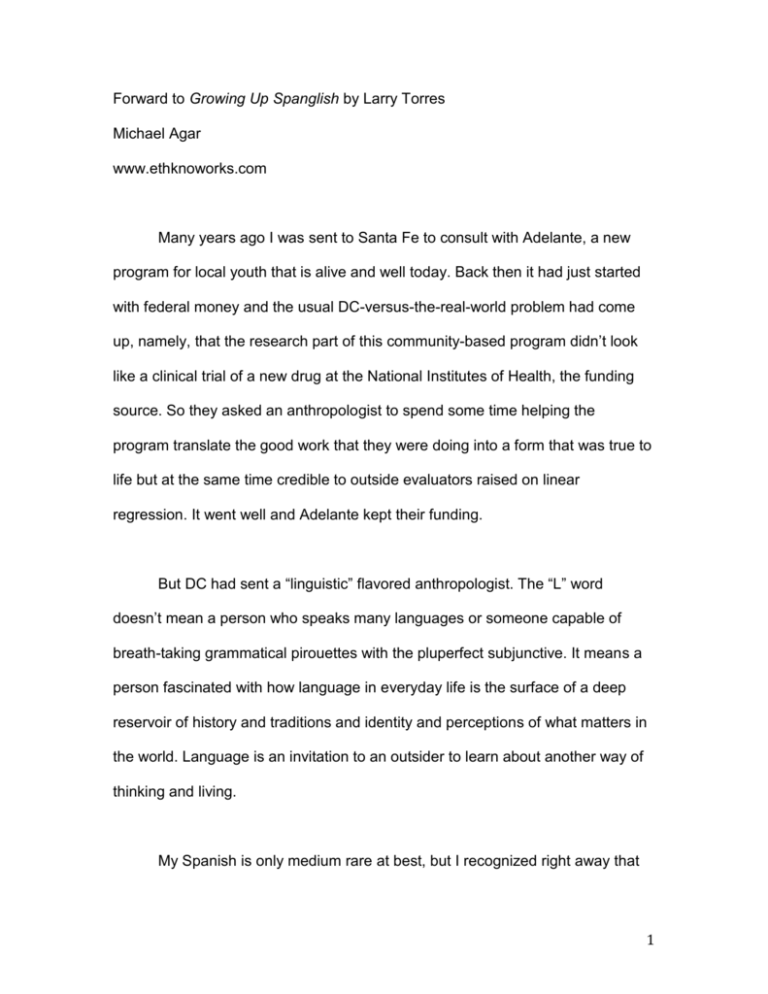Forward to Torres book, a collection of his Growing Up Spanglish
advertisement

Forward to Growing Up Spanglish by Larry Torres Michael Agar www.ethknoworks.com Many years ago I was sent to Santa Fe to consult with Adelante, a new program for local youth that is alive and well today. Back then it had just started with federal money and the usual DC-versus-the-real-world problem had come up, namely, that the research part of this community-based program didn’t look like a clinical trial of a new drug at the National Institutes of Health, the funding source. So they asked an anthropologist to spend some time helping the program translate the good work that they were doing into a form that was true to life but at the same time credible to outside evaluators raised on linear regression. It went well and Adelante kept their funding. But DC had sent a “linguistic” flavored anthropologist. The “L” word doesn’t mean a person who speaks many languages or someone capable of breath-taking grammatical pirouettes with the pluperfect subjunctive. It means a person fascinated with how language in everyday life is the surface of a deep reservoir of history and traditions and identity and perceptions of what matters in the world. Language is an invitation to an outsider to learn about another way of thinking and living. My Spanish is only medium rare at best, but I recognized right away that 1 the Spanish and English and mixes of the two that I heard from colleagues and kids at Adelante was the surface beneath which lay a wealth of what for me was a different world to explore. Our brief conversations inspired by something they said were an introduction to a long and complicated history about which I knew nothing. Shortly after moving to New Mexico years later my education continued when I learned of the “Heritage Spanish” program at the University of New Mexico. (More at http://spanport.unm.edu/undergraduate/languageprograms/spanish-heritage-program.html). The program, explained a professor, was developed for the many students who had grown up in the midst of Nuevomexicano culture but never mastered the language of the abuelos y abuelas that went with it. The UNM program offered Spanish using concepts that represented histories and traditions that the students already knew. It reminded me of my Irish ancestors, who wound up using a second language—British English— but who then sent their descendants to school to learn the Irish that originally shaped their tradition. Then one day, not so long ago, a column appeared in the Santa Fe New Mexican, my local paper, called "Growing Up Spanglish” by Larry Torres. Reading it felt like a privilege, an invitation into a world I only knew superficially, not written with academic prose or a list of abstract facts, but through the eyes of young Canutito in Northern New Mexico and his childhood adventures with his 2 grandparents. Now and then I needed a little help from Rubén Cobos’ Dictionary of New Mexico & Southern Colorado Spanish, but Torres deftly includes paraphrases in English of what was said in Spanish, so the columns are easily accessible to an English speaker as well. The stories, as a reader is about to see in this collection, are warm scenes of Nuevomexicano life, written in “Spanglish," the mix of Spanish and English that is the living language in which those scenes took shape. “Spanglish” is a word coined by a Puerto Rican poet in the 1940s, and he used it as a term of disrespect, a name for what appeared to him to be an incoherent mix of two languages that corrupted both. The word is still used that way by some, though things have changed mightily with celebrations and uses of Spanglish in literature and music and film, and with the development of its own academic experts. The shift reflects the growing worldwide community of speakers who mix knowledge of Spanish and English when they communicate with each other. The story is too long to tell here, but a look at the entry for “Spanglish" in Wikipedia isn’t such a bad first step for the curious novice. Don’t stop there though. It’s fascinating and far from over. Spanglish is an elusive linguistic beast. It is not a dialect or creole of either Spanish or English. It offers choices where a speaker might “code-switch” from one language to another in different ways, that term being a piece of linguistic jargon. There are “calques”—another bit of jargon—where an expression in one 3 language is translated directly into another, like “llamar atras” for the English “call back.” Spanglish isn’t the same everywhere by any means. Of course neither is Spanish nor English for that matter. Whatever else it is, though, Spanglish—like any language used by a community when they talk and act together--is a “form of life,” to use the words of the philosopher Ludwig Wittgenstein. That’s what Torres captures so well in his stories, showing rather than telling the world of old Hispanic New Mexico in a way that makes insider-readers smile in recognition and outsiders wonder at how it can be at the same time both so unknown and yet so familiar. Torres’ columns, the ones in this collection and the ones he still writes for the New Mexican, will be of interest to anyone who lives in—or who is interested in—New Mexico. I imagine they’d also be fun for students at any level. And I can imagine researchers looking at the patterns of Northern New Mexican Spanglish in the columns and comparing them to the patterns emerging all over the country among the growing population who—however proficient they might be in Spanish or English separately—blend parts of both to signal shared traditions with family and friends. Torres’ columns are a window into that New Mexican world. Enjoy spending some time there in the town in Northern New Mexico where Canutito and his grandparents live. 4











